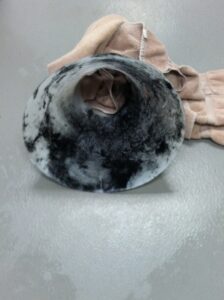-
Adopt
-
Veterinary Care
Services
Client Information
- What to Expect – Angell Boston
- Client Rights and Responsibilities
- Payments / Financial Assistance
- Pharmacy
- Client Policies
- Our Doctors
- Grief Support / Counseling
- Directions and Parking
- Helpful “How-to” Pet Care
Online Payments
Referrals
- Referral Forms/Contact
- Direct Connect
- Referring Veterinarian Portal
- Clinical Articles
- Partners in Care Newsletter
CE, Internships & Alumni Info
CE Seminar Schedule
Emergency: Boston
Emergency: Waltham
Poison Control Hotline
-
Programs & Resources
- Careers
-
Donate Now
 by Catherine Sumner, DVM, DACVECC
by Catherine Sumner, DVM, DACVECC
www.angell.org/emergency
emergency@angell.org
781-902-8400
MSPCA-Angell West, Waltham
Toxin exposure is a common reason for animals to present to a veterinarian. Activated charcoal (AC) is regularly used in toxin management as a gastrointestinal decontamination measure. While use in human medicine is decreasing, due to more advanced treatments being available, veterinarians continue to use AC regularly, as these other options are often not available, or cost prohibitive.
 AC is an adsorbent: a substance/surface to which other molecules (adsorbates) can adhere when they come in contact. It has an internal pore structure, creating a large surface area (commercial preparations usually 1000-2000 m2/g). As surface area increases, the number of adsorbate binding sites increases. When a toxin in the GI tract adsorbs to AC, it is no longer available for systemic absorption and is excreted in the feces along with AC. Studies show that it takes 30 minutes from AC administration to reach equilibrium of toxin adsorbed to AC. Adsorption of a toxin to AC is a reversible process (desorption), but desorption is a slower process and the clinical significance is unclear. There is no gastrointestinal absorption of AC, thus all AC administered is excreted in the feces. Due to its dark color, it is easily visible in the stool.
AC is an adsorbent: a substance/surface to which other molecules (adsorbates) can adhere when they come in contact. It has an internal pore structure, creating a large surface area (commercial preparations usually 1000-2000 m2/g). As surface area increases, the number of adsorbate binding sites increases. When a toxin in the GI tract adsorbs to AC, it is no longer available for systemic absorption and is excreted in the feces along with AC. Studies show that it takes 30 minutes from AC administration to reach equilibrium of toxin adsorbed to AC. Adsorption of a toxin to AC is a reversible process (desorption), but desorption is a slower process and the clinical significance is unclear. There is no gastrointestinal absorption of AC, thus all AC administered is excreted in the feces. Due to its dark color, it is easily visible in the stool.
AC can be obtained in various forms, including capsules, gel, granules, powder, suspension, or tablets. Human studies comparing the suspension with tablets or capsules of AC have shown the suspension to be significantly more effective. Suspension formulations are available that combine AC with a cathartic, which quickens gastrointestinal transit time, decreasing time for systemic absorption. Sorbitol, an osmotic saccharide cathartic, is used most commonly. Cathartics are not recommended in young patients, as well as those with dehydration, severe vomiting/diarrhea, or pre-existing renal disease. If you are stocking a combination AC/sorbitol product, it is important to also stock AC with no additives.
When considering administration of AC, an important question is whether the toxin ingested will adsorb to it. Patient factors such as temperature, rate of gastric motility, and other gastric contents can affect adsorption. pH has been shown not to affect adsorption within the range of pH 1.2-7.5 (normal canine gastric pH is 1.3-2.5). The surface area, particle, and pore size of the AC administered determine effectivity. Toxin factors such as solubility and ionization affect absorption. There is some disagreement as to which toxins AC is effective for. When faced with a suspected intoxication with an unknown toxin, administration of AC is recommended, as long as there are no contraindications. Since AC is an effective adsorbent for many toxins and has few side effects when used appropriately, the benefits outweigh the risks.
The published recommended doses for AC range from 1-5 grams/kilogram of body weight. However, for most commercially available AC suspensions, administering >1 gm/kg results in a prohibitive volume. It has been reported that a ratio of >/= to 10:1 of AC to toxin is ideal. In some cases we consider repeated AC doses. This is of use in toxins that have enterohepatic recirculation (cholecalciferol, NSAIDS, tetrahydrocannabinol, theobromine), with sustained-release drug ingestion or in toxins that have a long halflife. Half of the initial dose is given at 4-8 hour intervals for 3-4 doses for enterohepatic recirculation. A cathartic should only be used in the first dose.
Some animals will drink AC, but in many, AC is administered orally via syringe. Syringe feeding risks aspiration and can be messy. Placement of a feeding tube can be considered in sedate animals. Correct placement should be documented with a radiograph, and intubating the patient should be considered. Food can be added to AC to increase the likelihood of voluntary ingestion. A JVECC, 2013 study (Wilson, et al.) evaluated adding canned dog food to AC. While adding dog food to AC did statistically significantly decrease the total adsorptive capacity of AC, the decrease in adsorptive capacity was unlikely to be of clinical significance in most cases. In this study, ratios from 2:1 to 14:1 (dog food:AC) were evaluated, and only small changes in the adsorption were noted.
Human studies have shown improved outcomes when gastric evacuation is combined with administration of AC, versus AC alone. A recent prospective veterinary study (JVECC 2009) comparing AC alone versus AC after emesis did not show a significant difference. Apomorphine is the most commonly used emetic agent. AC can adsorb ipecac syrup, decreasing its emetic effect.
To achieve maximum efficacy, AC should be administered as soon after toxin ingestion as possible. In humans, the American Academy of Clinical Toxicology position statement states that the greatest benefit is achieved when AC is given within 1 hour of ingestion. When ingestion occurred >1 hour prior, there is insufficient evidence to show a benefit (or detriment) to administration. AC should still be considered in cases where potential toxin ingestion occurred > 1 hour prior, particularly in cases showing clinical signs.
Contraindications to AC administration include an unprotected airway, GI tract perforation, patients at risk for GI tract perforation or hemorrhage, and patients at risk for aspiration. It can affect visualization in patients needing endoscopy. It should not be used in patients with a GI obstruction. Finally, patients that are already hyperosmolar should be treated with caution. Overall, complications with AC administration are relatively infrequent. It has a wide safety margin; doses of 15 gram/kg are not fatal. Some animals will vomit after administration; we often give a parental antiemetic prior. There are reports of corneal abrasions as a result of direct contact. With repeated dosing, constipation can occur. Another important potential complication is hypernatremia. This is seen in young animals, animals receiving multiple doses, and with cathartics. AC results in osmotic fluid shifts into the intestinal tract. Patients with increased free water loss and those that are severely dehydrated are also more prone to the development of hypernatremia. Ideally, hydration status should be evaluated before administration of AC. It is recommended to monitor the sodium level 2-4 hours after administration of AC/sorbitol. To help avoid development of hypernatremia, patients can be placed on IV fluids, especially if they are dehydrated.
In summary, the risks and benefits of AC administration should be considered for each individual case. As it is an inexpensive treatment with few complications, it is frequently appropriate to use in cases of known and unknown toxin ingestion.
| Does Bind Well to Activated Charcoal | Does NOT Bind Well to Activated Charcoal |
| Acetaminophen Anticoagulant rodenticides Digoxin Non polar compounds Organophosphate/carbamate insecticides Pyrethrins/Pyrethroids Salicylates Strychnine |
Alcohols Caustic acids and alkalis Ethylene glycol Heavy metals (arsenic, copper, iron, lead, lithium) Inorganic toxins (ammonia, borates, bromide, fluoride, chlorate, cyanide, iodide, nitrates, nitrites, phosphorus, sodium chloride) Metaldehyde Mineral acids Nitrates Paraquat Petroleum distillates (gasoline, kerosene, xylene, transmission fluid) Salt toxicosis (playdough, table salt, paintballs) Xylitol |
For more information about Angell’s Emergency/Critical Care service, please visit www.angell.org/emergency. Dr. Sumner can be reached at MSPCA-Angell West in Waltham at 781-902-8400.
References:
American Academy of Clinical Toxicology. Position statement: single-dose activated charcoal. Clin Tox 1997; 35(7): 721-741.
American Academy of Clinical Toxicology. Position statement and practice guidelines on the use of multi-dose activated charcoal in the treatment of acute poisoning. Clin Tox 1999; 37(6): 731-751.
Bahri LE. Activated Charcoal. Comp of Vet Med 2008: 596-598
Ball A. Toxicology case: managing hypernatremia after activated charcoal administration. Vet Med, 2014.
Lapus RM. Activated charcoal for pediatric poisonings: the universal antidote? Curr Opin Pediatr. 2007; 19(2): 216-222.
Lee JA. Complications & controversies of decontamination: activated charcoal – to use or not to use? In: Proceedings of the American College of Veterinary Internal Medicine Conference. Anaheim (CA): 2010: 677-679.
Schildt J, Jutkowitz LA, Beal MW, et al. Effect of activated charcoal alone versus emesis and activated charcoal on carprofen absorption following experimental overdose in dogs. (abstract) J Vet Emerg Crit Care 2009: A6-A7.
Wilson HE, Humm KR. In vitro study of the effect of dog food on the adsorptive capacity of activated charcoal. J Vet Emerg Crit Care 2013; 23(3): 263-267.